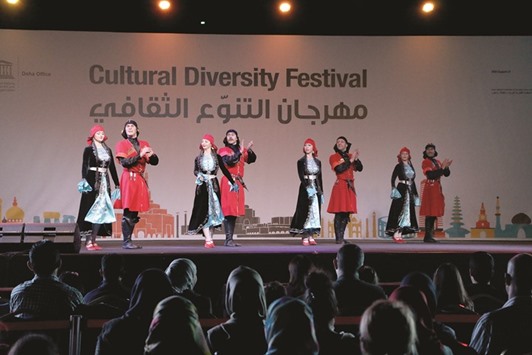Through a display of their elegant and unique culture dating back hundreds of years, the Circassians from Jordan enthralled the Doha audience for two days with their dance forms and songs.
Young girls and boys in colourful and traditional costumes from Al Ahli Club Jordan captivated and inspired the audience at Katara Cultural Village during its Cultural Diversity Festival recently. By combining music and dance into one, the dancers performed breathtaking moves with energetic music each with its own meaning and story. A large number of people gathered to cheer the unique Circassian performances.
They would go up in cheers as the female dancers would gracefully flow across the stage and synchronise the moves with the male dancers in creating beautiful formations. “We are part of the Jordanian cultural diversity. We are Circassian, originally from North-West Caucasus. We had to leave our homeland 150 years ago and we are now part of the Jordanian culture,” Hameed Abzakh, Troupe Manager, Al Ahli Club Jordan told Community in a chat after the performance.
All the participants were volunteers performing for Al Ahli Ensemble of Circassian Jordan. “The reason these boys and girls come forward and volunteer is that they believe in what they are doing. They are trying to preserve the culture and traditions through the performances such as the one you saw today,” said Abzakh.
He added that the Circassian are living all around the world in 42 countries but Jordanians have their signature style which is very different. Any Circassian will listen and see, and would identify easily that this comes from Jordan, he added.
“For hundreds of years, these dances have been an integral part of our celebrations. The costumes are only for stages or festivals. But in our weddings and gatherings, we perform the same dances with the same traditions but in routine regular dresses of course,” said the troupe manager.
“We try to develop the dance forms. We have red lines and borders up to where we can explore. Every move in the dance means something. For instance, some moves depict a hunter going to hunt and he cannot traditionally touch the gear,” he explained.
“Some dances are for the harvest season, some for war and some for celebrations. We have dances for migration. The last dance that you saw belongs to the people who have vanished now. As you listen and see, all their songs and moves are inspired by the heartbeat,” said Abzakh.
The Al Ahli Club Jordan, he said, has performed worldwide in many countries and at many festivals. “We went with Unesco to France and Turkey, we were the first troupe from the Middle East to perform at the Opera House in Egypt, we went to USA and Palestine twice, we went to Italy for the opening of the handball World Cup of women,” said the manager.
All performers are volunteers who carry their traditions.
“They have to deliver, they have to show the people the story of Circassia. Our children, when they are 3-4 years old, they see these dances in the weddings and they try to imitate their elders. So by the time they grow up, they are semi-professionals,” said the dance troupe manager.
He said they had a special trainer who came from Caucuses, their homeland to do the choreography while the musicians were also volunteers from Jordan. It was their first time in Doha.
“The audience was just fantastic. People have been very interested in knowing about the dance forms and the costumes and asked questions. I would say people here are very rich in culture to be honest. We were thrilled,” said Abzakh.
There are many forms of Circassian dances such as Apsni Apsua, the famous Abkhaz dance.
Abkhazians are considered part of the Circassians. They are very close in blood, language, culture, traditions with the Adyghe. In time Adyghe adopted their brothers’ and neighbours’ dance.
Qamachas, another form, is the dagger dance. The dancer shows his skill with the ‘Qama’, the Circassian dagger. It is a fast dance and it is a competition dance between men, and sometimes it is danced as solo.

SPECTACLE: Circassian dances are popular all across the world for their style and moves.
